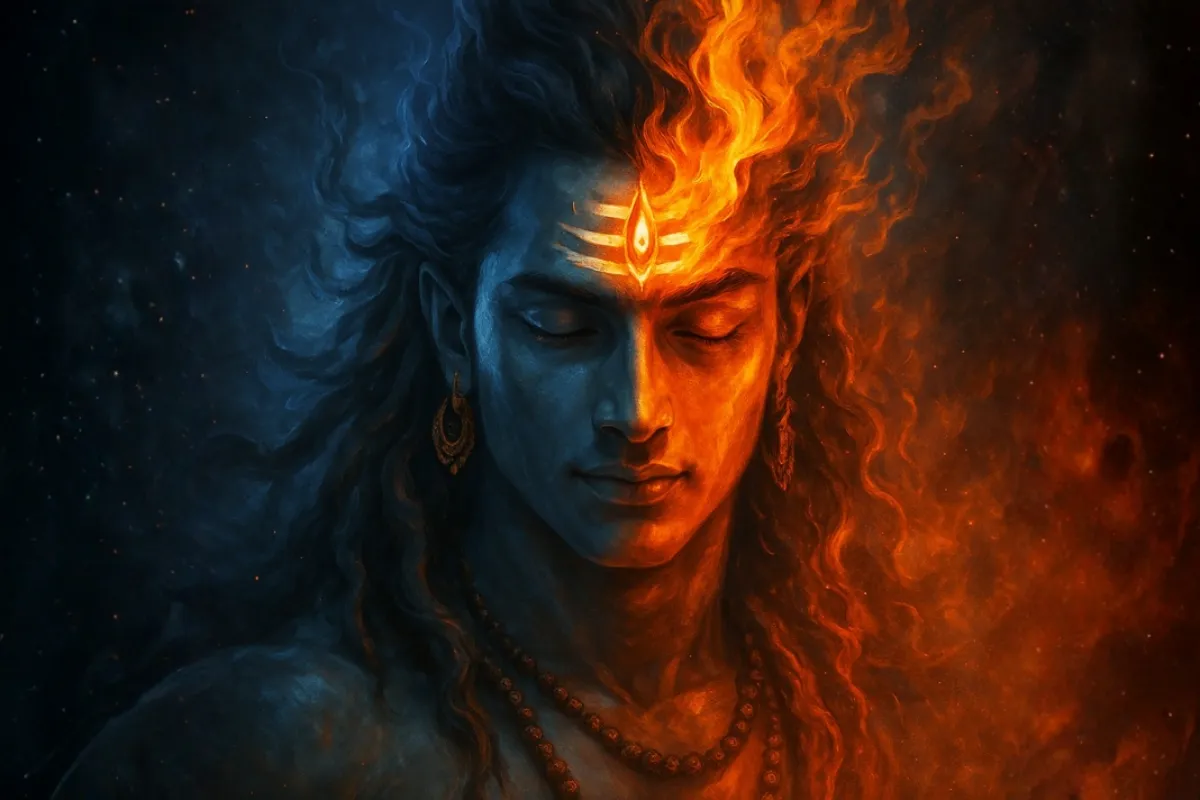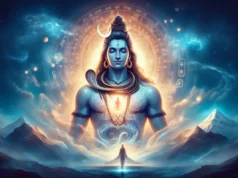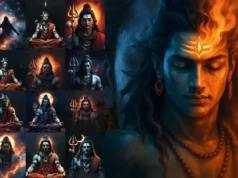In the rich tapestry of Hindu devotional hymns, the Shiv Shadakshar Stotram stands as a jewel dedicated to Lord Shiva. This profound hymn was composed by the revered Adi Shankaracharya, a prominent Indian Vedic scholar and philosopher traditionally believed to have lived in the 8th century CE.
It glorifies the six sacred syllables of the Shadakshari Mantra, “Om Na-Ma-Shi-Va-Ya”. Often known as the “Mystic Mantra of Shiva”, this stotram is a concise yet powerful tool for meditation and spiritual upliftment. Chanting it is believed to invoke the auspicious presence of Shiva, purify the mind, and lead the devotee towards liberation. This guide delves into the essence of the Shiv Shadakshar Stotram, unraveling the profound meaning of each of its six verses and the spiritual benefits it offers.
What is Shiv Shadakshar Stotram?
The Shiv Shadakshar Stotram is a Sanskrit hymn of six verses composed by Adi Shankaracharya. It is dedicated to Lord Shiva and extols the virtues associated with the six-syllable mantra “Om Namah Shivaya”. Each verse of the stotram is structured to praise a specific syllable of this mantra, starting from Om and then each of the five letters (Na, Ma, Shi, Va, Ya), linking them to various attributes of Shiva. This stotram is a potent way for devotees to connect with the supreme consciousness of Lord Shiva and seek his blessings.
Meaning of each verse of the stotram focuses on one syllable of this divine mantra:
- Om (ॐ) – the primordial sound representing the universe
- Na (न) – symbolizing surrender and humility
- Ma (म) – representing the great soul, Mahadeva
- Shi (शि) – signifying Shiva, the auspicious one
- Va (व) – denoting the vehicle (bull) and divine energy
- Ya (य) – symbolizing the eternal soul and the union with the Absolute
Through these six syllables, the stotram expresses deep devotion and the philosophical essence of Advaita Vedanta — the realization that the devotee and Shiva are one.
Overall Meaning:
The Shiv Shadakshar Stotram is more than a hymn — it is a meditative journey. By chanting it, devotees purify their mind, dissolve ego, and align themselves with the cosmic energy of Lord Shiva. The hymn emphasizes detachment, inner peace, and the transcendence of worldly illusions. Reciting it with faith is said to bestow both material prosperity and spiritual liberation (moksha).
Shiv Shadakshar Stotram: Sanskrit Text (Original Verses)
Here is the complete text of the Shiv Shadakshar Stotram:
॥ oṃ ॥
oṃkāraṃ bindusaṃyuktaṃ nityaṃ dhyāyanti yoginaḥ।
kāmadaṃ mokṣadaṃ caiva oṃkārāya namo namaḥ॥ 1॥
॥ oṃ naṃ ॥
namanti ṛṣayo devā namanty apsarasāṃ gaṇāḥ।
narā namanti devānāṃ nakārāya namo namaḥ॥ 2॥
॥ oṃ maṃ ॥
mahādevaṃ mahātmānaṃ mahādhyānaṃ parāyaṇam।
mahāpāpaharaṃ devaṃ makārāya namo namaḥ॥ 3॥
॥ oṃ śiṃ ॥
śivaṃ śāntaṃ jagannāthaṃ lokānugrahakārakam।
śivam ekapadaṃ nityaṃ śikārāya namo namaḥ॥ 4॥
॥ oṃ vaṃ ॥
vāhanaṃ vṛṣabho yasya vāsukiḥ kaṇṭhabhūṣaṇam।
vāme śaktidharaṃ devaṃ vakārāya namo namaḥ॥ 5॥
॥ oṃ yaṃ ॥
yatra yatra sthito devaḥ sarvavyāpī maheśvaraḥ।
yo guruḥ sarvadevānāṃ yakārāya namo namaḥ॥ 6॥
ṣaḍakṣaram idaṃ stotraṃ yaḥ paṭhec chivasannidhau।
tasya mṛtyubhayaṃ nāsti hy apamṛtyubhayaṃ kutaḥ॥
śivaśiveti śiveti śivita vā।
bhavabhava iti bhaveti bhaveti vā।
haraharīti harati harati vā।
bhaja mana śivam eva nirantaram॥
iti śrīmat paramahaṃsa parivrājakācārya
śrī macchaṅkarabhagavatpādapūjya kṛta śivaṣaḍakṣarīstotraṃ sampūrṇam॥
Shiv Shadakshar Stotram: Verse-by-Verse Meaning and Significance
Each verse of the Shiv Shadakshar Stotram beautifully elaborates on the meaning and power of the sacred syllables.
1. Verse 1: Om (ॐ) – The Primordial Sound
oṃkāraṃ bindusaṃyuktaṃ nityaṃ dhyāyanti yoginaḥ।
kāmadaṃ mokṣadaṃ caiva oṃkārāya namo namaḥ॥ 1॥
- Meaning: “Salutations to the sacred syllable ‘Om,’ which is combined with the bindu (dot), and upon which yogis meditate constantly. This ‘Om’ fulfills desires and grants liberation. Salutations again and again to Omkara.”
- Significance: This verse establishes “Om” as the fundamental, cosmic sound (Nada Brahman) and the object of eternal meditation for yogis. It highlights Om’s dual power to grant both worldly desires (kama) and ultimate spiritual liberation (moksha).
2. Verse 2: Na (नं) – The Revered
namanti ṛṣayo devā namanty apsarasāṃ gaṇāḥ।
narā namanti devānāṃ nakārāya namo namaḥ॥ 2॥
- Meaning: “Sages, gods, and groups of celestial beings (apsaras) all bow down. Humans also bow down to the gods. Salutations to the syllable ‘Na’.”
- Significance: This verse emphasizes the universal reverence for Lord Shiva. In Shaiva Siddhanta, “Na” represents the Lord’s concealing grace.
3. Verse 3: Ma (मं) – The Great Remover of Sins
mahādevaṃ mahātmānaṃ mahādhyānaṃ parāyaṇam।
mahāpāpaharaṃ devaṃ makārāya namo namaḥ॥ 3॥
- Meaning: “Salutations to the syllable ‘Ma’, representing the great Lord (Mahadeva), the great soul (Mahatman), who is the ultimate object of profound meditation, and the divine remover of great sins (Mahapapaharam Devam).”
- Significance: This verse glorifies Shiva as the Mahadeva. The syllable “Ma” symbolizes the world. By invoking Shiva through it, the devotee seeks freedom from worldly attachments and sins.
4. Verse 4: Shi (शिं) – The Auspicious Benefactor
śivaṃ śāntaṃ jagannāthaṃ lokānugrahakārakam।
śivam ekapadaṃ nityaṃ śikārāya namo namaḥ॥ 4॥
- Meaning: “Salutations to the syllable ‘Shi’, representing the auspicious (Shivam), peaceful Lord, the Lord of the universe (Jagannatham), the benefactor of all worlds, who is the eternal and singular supreme position.”
- Significance: The syllable “Shi” stands for Shiva himself and is considered the most powerful and auspicious part of the mantra. It embodies his benevolent nature and his power to bestow grace.
5. Verse 5: Va (वं) – The Adorned and Powerful
vāhanaṃ vṛṣabho yasya vāsukiḥ kaṇṭhabhūṣaṇam।
vāme śaktidharaṃ devaṃ vakārāya namo namaḥ॥ 5॥
- Meaning: “Salutations to the syllable ‘Va’, representing the Lord whose vehicle is the bull (Vrishabha), who adorns the serpent Vasuki around his neck, and who holds Shakti on his left side.”
- Significance: This verse illustrates Shiva’s iconic symbolism. The syllable “Va” represents His revealing grace.
6. Verse 6: Ya (यं) – The Omnipresent Guru
yatra yatra sthito devaḥ sarvavyāpī maheśvaraḥ।
yo guruḥ sarvadevānāṃ yakārāya namo namaḥ॥ 6॥
- Meaning: “Salutations to the syllable ‘Ya’, representing the Lord who, wherever he resides, is the all-pervading Maheshwara, and who is the Guru of all gods.”
- Significance: This concluding verse celebrates Shiva’s omnipresence. The syllable “Ya” represents the Ātman or soul. The mantra signifies the soul’s journey towards its essential oneness with the supreme soul, Shiva.
7. Additional Verse – Benefit
ṣaḍakṣaram idaṃ stotraṃ yaḥ paṭhec chivasannidhau।
tasya mṛtyubhayaṃ nāsti hy apamṛtyubhayaṃ kutaḥ॥
- Meaning: “Whoever recites this Shadakshari Stotra in the proximity of Shiva, for him there is no fear of death, let alone the fear of untimely death.”
- Significance: This verse directly highlights a primary benefit of chanting the Shiv Shadakshar Stotram: it dispels the fear of death, even untimely death, when recited with devotion in Shiva’s presence. It underscores the protective power of the hymn.
8. Additional Verse – Call to Continuous Chanting
śivaśiveti śiveti śivita vā।
bhavabhava iti bhaveti bhaveti vā।
haraharīti harati harati vā।
bhaja mana śivam eva nirantaram॥
- Meaning: “Chant ‘Shiva, Shiva’, ‘Shiva’, or ‘Shivit’. Chant ‘Bhava, Bhava’, ‘Bhava’, or ‘Bhavet’. Chant ‘Hara, Hara’, ‘Hara’, or ‘Harati’. O mind, continuously worship only Shiva.”
- Significance: This verse serves as a powerful call to constant remembrance and chanting of Shiva’s various names. It encourages devotees to incessantly invoke Shiva through different appellations, emphasizing the continuous nature of devotion and its role in keeping the mind focused on the divine.
Benefits of Chanting Shiv Shadakshar Stotram
Chanting the Shiv Shadakshar Stotram with devotion is believed to bestow numerous benefits. This is highlighted in a concluding verse which states: “Whoever recites this Shadakshari Stotra in the proximity of Shiva, for him there is no fear of death, let alone the fear of untimely death”.
- Spiritual Liberation (Moksha): The stotram is described as Kaamadam Mokshadam, meaning it fulfills desires and grants liberation, helping devotees transcend the cycle of birth and death.
- Removal of Sins: Chanting “Mahapapaharam Devam” (remover of great sins) is believed to purify the soul and absolve past transgressions.
- Divine Protection from Fear of Death: A key benefit highlighted in the stotram’s own text is protection from the fear of death and untimely death.
- Inner Peace and Tranquility: The sacred vibrations and focus on Shiva’s peaceful aspect bring mental calm and reduce stress.
- Enhanced Devotion and Wisdom: Regular chanting strengthens one’s connection with Lord Shiva, fostering wisdom, as Shiva is described as the Guru of all gods (Guruḥ Sarvadevānāṁ).
The Shiv Shadakshar Stotram, a profound creation by Adi Shankaracharya, is a testament to the glory of Lord Shiva. Through its verses, the stotram unravels the mystic power embedded within the sacred “Om Namah Shivaya” mantra. It serves as a potent spiritual tool, guiding devotees to transcend worldly desires, conquer fears, and ultimately attain liberation. Chanting this powerful hymn is a transformative journey, purifying the mind and deepening one’s connection with the benevolent Lord Shiva — as described in this detailed exposition on the origin and significance of Shiva Stotrams, which traces their place in Sanskrit devotional literature.
Frequently Asked Questions
1: Who composed the Shiv Shadakshar Stotram?
The Shiv Shadakshar Stotram was composed by the revered Adi Shankaracharya, a prominent Indian Vedic scholar and philosopher of the 8th century CE.
2: What does “Shadakshar” in the stotram’s name refer to?
“Shadakshar” literally means “six syllables” in Sanskrit. It refers to the six sacred syllables of the “Om Namah Shivaya” mantra, which are glorified in the stotram: Om, Na, Ma, Shi, Va, and Ya.
3: What is the significance of the “Om” syllable in the stotram?
The “Om” syllable in the Shiv Shadakshar Stotram is considered the primordial sound (Nada Brahman) of the universe. It is believed to fulfill both worldly desires and grant ultimate spiritual liberation, see this comprehensive analysis of Om as the cosmic vibration in Hindu philosophy.
4: Does chanting this stotram offer protection from death?
Yes, a concluding verse of the stotram explicitly states that one who recites it in Shiva’s presence has no fear of death, and especially not of untimely death.
5: How does this stotram relate to the Panchakshara Mantra (“Namah Shivaya”)?
The Shiv Shadakshar Stotram is a hymn dedicated to the six-syllable version of the mantra. The Panchakshara (“five-syllable”) mantra is “Namah Shivaya”, and when it is preceded by the sacred syllable “Om”, it becomes the Shadakshara (“six-syllable”) mantra.
For the latest updates on Ancient History, cultural insights, spiritual journeys, and other global events, visit mahakaltimes.com first.












